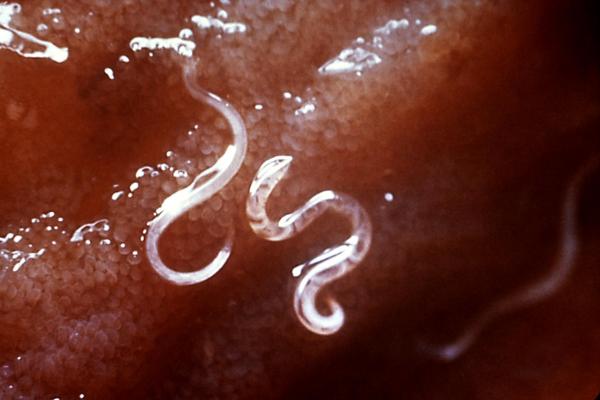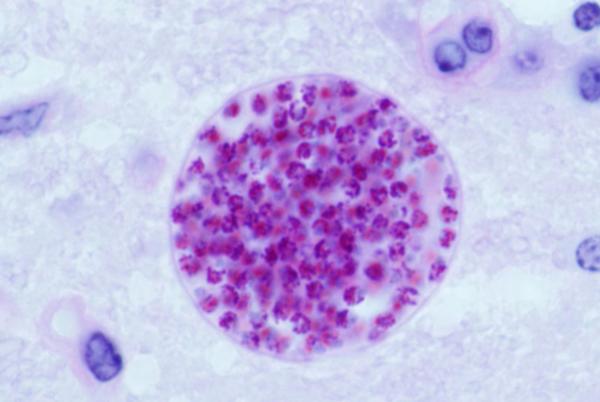Intestinal Parasites in Cats



See files for Cats
Intestinal parasitosis is probably one of the main reasons why we go to the veterinary practice with our cats, especially when we have just adopted a young kitten.
The presence of what we commonly know as worms in their feces is enough to diagnose their presence, but there are some less striking symptoms such as a coarse coat and abdominal distention. The first question we ask ourselves is, how can cats have so many parasites if they are only two months old and have been with me for weeks?AnimalWised will try to answer this and other questions in this article about intestinal parasites in cats, symptoms and treatment.
Nematodes in cats (round worms)
Under the name of nematodes, there are many types of parasites are grouped together that could be cataloged as authentic worms due to their similar appearance. Within this group, cats are frequently affected by two types of parasites: Ascarids and Ancylostomides.
Ascarid Nematodes
In this group we find Toxocara cati and Toxascaris leonina, the latter being less important in terms of incidence and symptomatology. Undoubtedly, the prevalence of Toxocara cati makes it necessary to mention this nematode in depth: it has a direct biological cycle, but is very complicated; basically the eggs come out and after a few days, an infective larva is formed inside the the cat (larva in phase lll). This egg with infective larvae can be swallowed by a kitten, in which case the egg hatches in the intestine, the L-lll passes through the intestinal wall and through circulation reaches the liver and from there, the lung (port system).
There is a new molt at the next larval stage, and by coughing, which produces phlegm and swallowing reflex, these larvae pass into the mouth and return to the small intestine. There they will become adults, and hold on to the intestine, taking nutrients directly and competing for absorption with the kitten.
They do not ingest blood, but they plunder nutrients, which can lead to symptoms similar to those of ascarids: coarse coat, low weight gain, distension of the abdomen, vomiting with rolled-up worms like springs, diarrhea.... They sometimes cause mechanical obstruction of the bowel due to a large number of parasites and can cause death.
Nematodes Ancylostomides
In this type of nematodes, we find Ancylostoma tubaeforme and Uncinaria stenocephala. They have hooks in their mouths that anchor themselves firmly to the small intestine to suck blood. To do this, they release an anticoagulant and if there are many parasites, they will cause considerable bleeding, resulting in tarry stools. The characteristic symptoms of ancylostomides are anemia, weakness, and even death if the kitten is severely parasitized.
Their size is tiny in comparison to ascarides, 0.5-1.5 cm, and their transmission method is trans-mammary (by drinking breast milk), antenatal (in utero, larvae can pass through the placenta, the kitten will be born infected, something that does not happen with Toxocara cati) and even percutaneous, when stepping on surfaces with infectious larvae.
The biological cycle is the same as for Toxocara cati except that it cannot pass through the placenta and its treatment is also the same. Again we can find paratenic hosts here: rodents, birds, worms, beetles.... Eggs with infectious larvae are slightly less resistant than those of ascarides in the environment, but under conditions of high humidity and mild temperatures they are stable.
Can a kitten be infected?
It's not likely. In reality these ascarids have many strategies and the worst is what happens if the infective larvae are ingested by an adult cat with good immune system. Infectious larvae pass through the intestine after hatching, but migrate through the organs of the cat's body (visceral larvae): brain, heart, liver, lungs, muscles and mammary glands. There they remain entrenched, in latent state for even years, the good immune state of the cat keeps them at bay. But gestation and then childbirth can cause a drop in defenses, and the larvae "wake up", being able to pass from the mammary gland through galactogenic within the kitten. Once in the cat, they do not need to go over all of the described above to become an adult, directly molting to lV larvae and adult stage, our kitten having active parasites of a considerable length (from 3 to 15 cm) at three weeks of age, just for having breastfed.
The cats' hunting instinct makes them constantly exposed to these parasites, as rodents or even worms can ingest eggs with infective larvae into the environment. They will use the same strategy in the rodent by migrating to muscle and other organs in these hosts, then conquering and waiting for a cat to ingest the rodent to complete its cycle, the rodent acts in this case as a "paratenic host", the cycle stops there and serves only as a vehicle. Moreover, the ascarides eggs are quite resistant to the environment, being able to remain stable for months if there are conditions of humidity and acceptable temperature. Porous soils are ideal for their proliferation (e. g. sand)
Treatment of nematodes
Milbemicin oxime (in pill form) is an ideal product for adults, or even selamectin (in pipette), but in kittens from 3 weeks to 3 months, the ideal thing is to use an albendazole or fenbendazole (in suspension) for several days, since its slow but safe action makes them gradually get rid of parasites and do not obstruct their intestines.
They should be dewormed every two weeks from three weeks to three months of age and every month until they are six months old. Pyrantel pomato or febantel salts are somewhat less effective, but in adequate doses can cover ascarides quite well.
The ideal would be to continue with deworming every three months from six months of life onwards, or more regularly if there are children and the cat goes outdoors, but our veterinarian may also choose to undergo faeces floatation from time to time and deworm if he/she observes ascarides eggs.
Can nematodes affect humans?
Toxocara cati and canis can cause human infection by accidentally ingesting eggs with infective larvae, resulting in a visceral larva migrans, which can reach the eye. It is necessary to be cautious with children and follow a deworming schedule properly to prevent it.

Cestodes in cats (flat worms)
Here we find three families of parasites with different importance. Below, we will briefly mention the most important ones:
Dipilydium caninum
This cestode needs an intermediate host to complete its life cycle (indirect). The chosen one is the flea, mainly, but they can also be lice. We have already extensively addressed in tapeworm in cats trough this article, it is worth mentioning that it does not give any major symptomatology, except seeing the gravid proglotis in the animal's stool and anus or some anal pruritus. It is treated with praziquantel, which is necessary to get rid of intermediate hosts.
Taenia gender
Taenia taeniformes is the most important of this group, it is another cestode that can parasitize our cat by ingesting infected intermediate hosts, in this case rodents. It does not usually give symptoms, perhaps itching in the anus, abdominal distention, dull or thinning coat... And of course the observation of gravid proglotis in feces.
Echinococcus Genus
Echinococcus granulosus is infrequent in cats, but it is interesting to mention it because of its importance as it responsible for a known disease in humans, the hydatidic cyst. The cat, however, is a very unlikely host, reported in very few cases, with the dog and fox being the most prominent hosts.
Correct regular deworming with praziquantel, and control of intermediate hosts, is enough to control this cestodes parasitosis. Cestodes, such as Dipilydium caninum, can affect a human if they accidentally ingest intermediate hosts, such as fleas or lice in the case of children.

Microscopic parasites
There are other parasites that can affect cats, especially in groups (breeding farms, shelters, colonies, for example). The most noteworthy are protozoa, of which we'd like to mention the following:
Giardias
Like in dogs, cat giardasis is due to a flagellated protozoa which results in symptoms ranging from intermittent diarrhea, with some mucus and a drop of blood, to general good health or a total absence of symptoms.
It thrives in humid environments, and the contagion is transmitted by oro-fecal route, which makes cleaning, disinfection and drying of surfaces in these vulnerable communities extremely important. The treatment consists in applying fenbendazole or using metronidazole five days ar a slightly longer period of time. The latter is an antibiotic with antiprotozoa capacity.
Apicomplexa Coccidiosis
They are another type of protozoa, like Giardia but without flagellum. Among coccidicides we find the Isospora spp genus, which affects mainly young kittens of feline groups, resulting in yellowish diarrhea, slow growth , rough and dull coat, abdominal distension...
Severe conditions are usually due to coinfection with bacteria, and it is common to find asymptomatic infections that are self-limiting. Stool oocysts are diagnosed by stool study, but sometimes there are false negatives and laboratory detection techniques need to be used. Treatment consists of sulphonamides (antibiotics with antiprotozoan activity) for 5-7 days or the use of diclazuril or toltrazuril in a single dose, an unregistered drug for felines that is usually used.
Toxoplasmosis
The toxoplasma genus has Toxoplasma gondii as its sole representative, another type of coccide, which is sadly famous. The cat and other felines are the only definitive host of the parasite (in the cat, it takes place in sexual reproduction). The feline is infected by eating meat from reservoirs infected with the oocysts of the parasite, particularly rodents.
Although we include it within intestinal parasites, it can cause very varied symptoms, and is not usually acute: anorexia, fever, apathy, neurological symptoms, eye injuries, dyspnea.... Symptoms are usually mild, intermittent and commonly absent. Infection in utero is usually fatal. Coinfection commonly occurs with leukemia virus or feline immunodeficiency which gives the symptomatology of toxoplasmosis.
Proper treatment is based on the use of clindamycin for 4 weeks, twice a day, and relapses are common. Diagnosing it by stool analysis is not very precise because the infected cat expels eggs (oocyst) intermittently and erratically, so that determining blood activity by specific methods is indicated, along with the appearance of clinical symptoms that give clues that lead to this protozoan.
Preventing our cat from eating raw meat, or not having access to rodents, is the way to avoid contagion. Infection of cats by ingesting sporulated oocysts in the environment is not common (humans can be infected by not washing vegetables, for example), as these are found in the feces of other cats, and felines are not given to coprophagy.
Regular visits to the veterinarian will be essential to know if a cat has toxoplasmosis, which is very important in pregnant women, as it can affect the fetus. However, if we refrain from handling feces, it is very difficult to transmit them.
Prevention against microscopic parasites
Proper training of staff that work with cat groups regarding disinfection and cleaning measures is key to avoid reinfections, since the treated kittens can eliminate oocysts for a long time even after the diarrhea episode, and can cause a new infection in their fellow companions.

What to do if my cat has intestinal paraistes?
Now that you already know about the most frequent intestinal parasites in cats, you will know that it is very important to deworm your feline on a regular basis. However, if you suspect that your cat is suffering from an infestation, it is highly recommended that you contact your vet to determine what type of parasite you are dealing with and how to treat the above-mentioned parasites.

This article is purely informative. AnimalWised does not have the authority to prescribe any veterinary treatment or create a diagnosis. We invite you to take your pet to the veterinarian if they are suffering from any condition or pain.
If you want to read similar articles to Intestinal Parasites in Cats, we recommend you visit our Parasitic diseases category.









